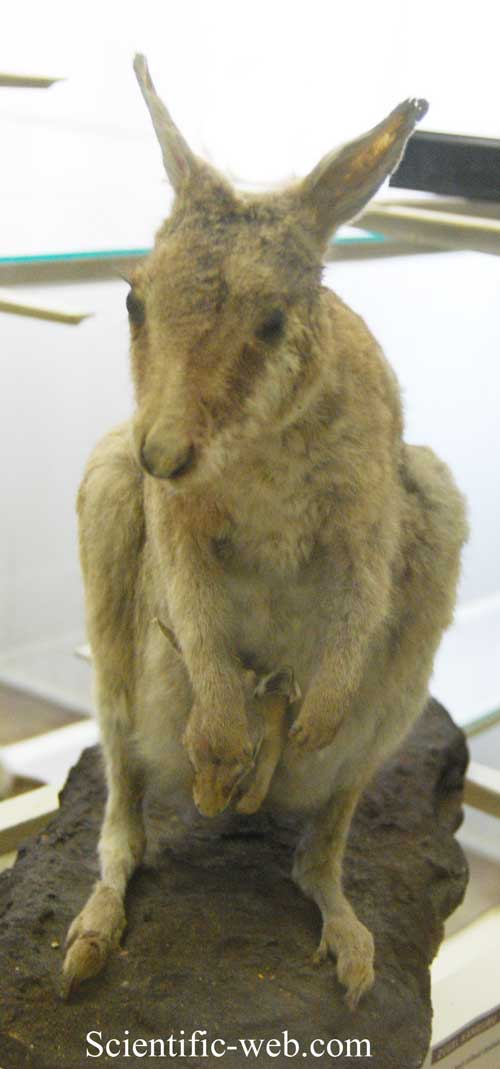Onychogalea fraenata, Photo: Michael Lahanas Cladus: Eukaryota Name Onychogalea fraenata (Gould, 1841) Type locality: Australia, New South Wales, interior Vernacular names
* Onychogalea fraenata on Mammal Species of the World. Bridled Nail-tail Wallaby refers to Onychogalea fraenata, an endangered species of marsupial. It is a small wallaby found in three isolated areas in Queensland, Australia, and whose population is declining. Estimations place the present total population of the species at around 500 individuals. Description
Key physical features are the bridle markings, a black dorsal stripe and the tail spur. Other markings include stripes on their cheeks, which is often seen in other species of wallabies as well. The tail spur can be 3–6 mm long and partly covered in hair. Its purpose is unclear. The "nail-tail" is a feature common to two other species of wallabies, the Crescent Nail-tail Wallaby and the Northern Nail-tail Wallaby. While the Crescent Nail-tail was declared extinct in 1956, the Northern Nail-tail wallaby still exists in steady populations in northern Queensland and the Northern Territory. The wallabies are most active during the night-time and dusk periods. Day is usually spent sleeping in hollows near bushes or trees. In modern habitats, Nail-tails keep close to the edges of pasture grasses. These wallabies have a strong reputation as shy and solitary animals. They may occasionally form small groups of up to four to feed together when grazing is in short supply. The Bridled Nail-tail Wallaby likes to avoid confrontation and has two main ways of avoiding threats – hiding in hollow logs and crawling under low shrubs. If caught in the open, it may try to lie completely still hoping not to be observed. Joeys are brought up in the mother's pouch. One young is born at a time and availability of food sources determine how often they breed. The gestation period is about 23 days and the joey stays in the pouch for around four months. History At the time of European settlement, Bridled Nail-tail Wallabies were common all along the East Australian coastline region to the west of the Great Dividing Range. Naturalists in the 19th century reported that the species ranged from the Murray River region of Victoria through central New South Wales to Charters Towers in Queensland.[2][3] The species declined in the late 19th and early 20th centuries with no confirmed sightings between 1937 and 1973, by which time it was believed to be extinct. After reading an article in a magazine about Australia's extinct species, a fencing contractor reported that there was an extant population on a property near Dingo, Queensland.[4][5] Recovery efforts Since its rediscovery, the Bridled Nail-Tail has been the target of private conservation efforts to re-establish viable populations. Captive breeding programs have allowed the establishment of three populations; two in State reserves located at Idalia and Taunton National Parks, and another on a private reserve, Project Kial, located near Marlborough in the Central Queensland region. There are an estimated 400–600 individuals.[4][6] Major threats to the species are predation by introduced species, namely feral cats and foxes. Protecting habitats from these predators is key to maintaining reserve populations. Scientific significance The Bridle Nail-Tail wallaby is of interest to marsupial researchers due to its immune system appearing to possess a hardier constitution than other species of marsupials. In the words of Central Queensland University based marsupial immunologist Lauren J Young, "These wallabies appear to be able to survive parasite infections, viruses and various diseases more readily than other marsupials".[6] References ^ McKnight, M. (2008). Onychogalea fraenata. In: IUCN 2008. IUCN Red List of Threatened Species. Downloaded on 28 December 2008. Database entry includes justification for why this species is listed as endangered Groves, C. (2005). Wilson, D. E., & Reeder, D. M, eds. ed. Mammal Species of the World (3rd ed.). Baltimore: Johns Hopkins University Press. pp. 66. OCLC 62265494. ISBN 0-801-88221-4. Source: Wikipedia, Wikispecies: All text is available under the terms of the GNU Free Documentation License |
|


